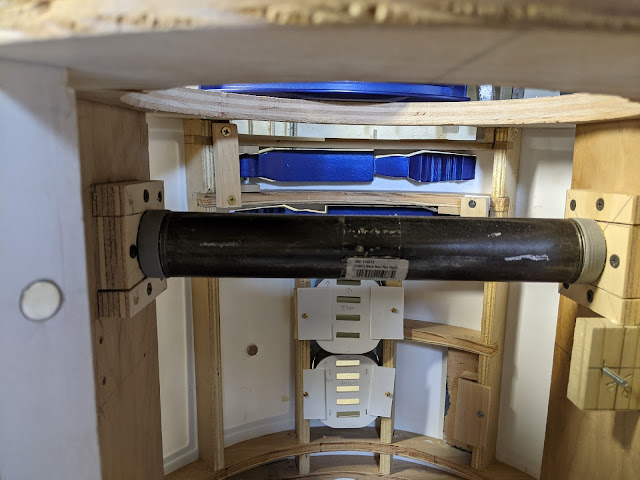The next step in making the skins was to cut out the paper template so I could use it to trace the template onto the styrene. You can faintly see the lines in the picture below. With the pattern transferred to the styrene I cut it out using an X-Acto knife. This was a very tedious process, you just need to take your time and periodically change your blade. In the spots where the pieces of the skins come together under the legs I left the styrene long and would trim it later during installation so I was sure I would get a tight seam.
Sunday, April 25, 2021
Sunday, April 11, 2021
Body Skins Part 1
By far one of the most challenging parts of building R2 was the skins. The skins are made of two layers of .04 inch styrene. The first challenge was finding the material. I was unable to find any place to get it local. I did find 4x8 sheets online but the shipping costs were outrageous. Eventually I found SIBE-R Plastic Supply which sold 24” x 48” pieces at a reasonable price and shipping.
This was not big enough to make each layer out of one piece, so I did each layer in two pieces, one for the front and one for the back. The seams were pretty small and were under the legs so where easy to hide. This also made the pieces easier to work with.
Below are pictures of the templates for the skins. I took these to a print shop and had them printed fully size. If you have them printed be sure to take some measurements to be sure they are printed at the right scale. The black areas are cut all the way through. On the outside layer you will make cut outs for the panels and the pieces that are cut out are further cut to make panel details.
There is a good article on Astromech.net with more information on the skins..
https://astromech.net/droidwiki/Making_Your_Own_Skins
Inner layer.
Outer layer
Sunday, April 4, 2021
Leg Mounting
Here is a look at how I mounted the legs to the frame., Each leg has a piece of threaded iron pipe screwed into the shoulder flange. I used a piece of pre-threaded pipe and just cut it in half.
The two smaller pipes attached to the legs then go into a larger piece of pipe.
To hold that larger pipe in place I added blocks on the inside of the frame. I also wrapped some tape around the pipe to keep it centered and not slide out.
To make the blocks I started with a square piece of plywood and then drilled a hole the same size as the pipe.
I then cut out one side of each piece on the band saw to provide a way to get the pipe in. In hindsight I realized I only really need to to this on side, there was enough room to get the pipe in on one side without the cut out.
I glued the main piece onto the frame and the screwed the smaller piece into place when the pipe was installed. To keep the legs in the correct orientation I drilled a hole through the frame and into the shoulder hub and then inserted a pin to hold the leg at the correct angle.










